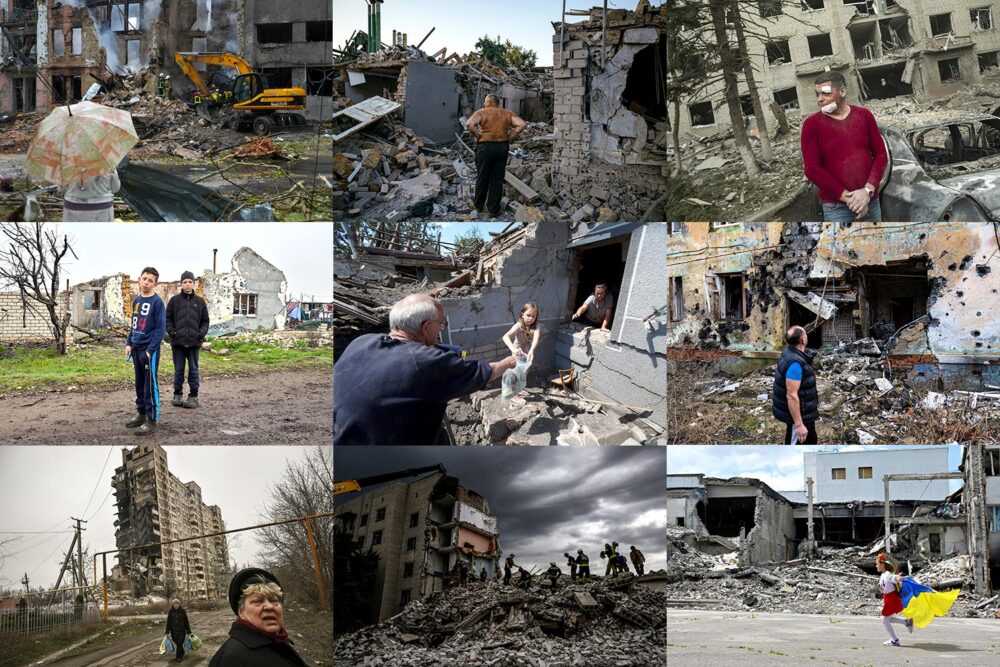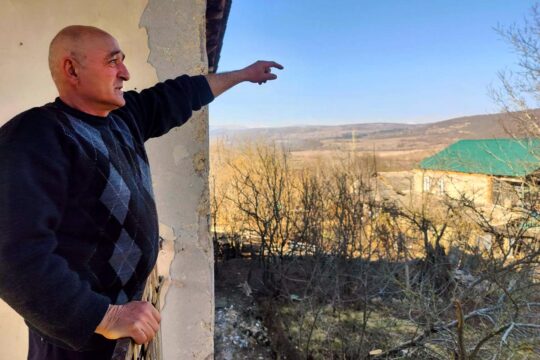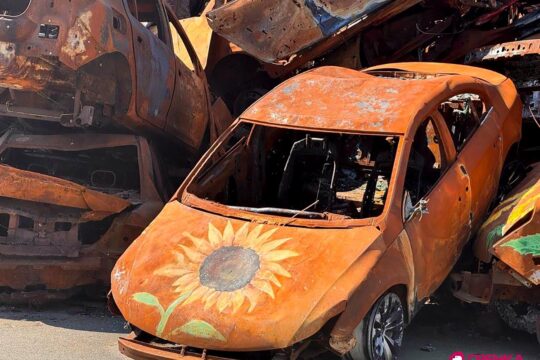A man had a beautiful house in the Kherson region in Ukraine. When Russian forces brutally attacked and occupied the area in 2022, he immediately fled. In the chaos the man lost the documents that proved he was the owner. Then he received information that his house was destroyed. When he heard about the new Register of Damage for Ukraine, he wondered how he could claim compensation. This story was told by Olesia Zaiets, project officer at the Ukraine Legal Network (ULN), during a seminar organized on 29 May at the T.M.C. Asser Institute in The Hague about the new mechanism.
To Zaiets, the Register is an important step in the long process of holding Russia to account for the immense harm it causes. Only nine months after the launch of the devastating invasion of Ukraine by the Federation of Russia, on 14 November 2022 the UN General Assembly adopted a resolution on the “Furtherance of remedy and reparation for aggression against Ukraine”, which recognized that victims and the State of Ukraine have the right to reparation under international law. The resolution called for the creation of an international register.
Half a year later, on 17 May 2023, the Council of Europe, representatives of the European Union, plus Canada, Japan and the United States set up what officially is called: the Register of Damage Caused by the Aggression of the Russian Federation against Ukraine. “It is the biggest practical meeting of minds of states on the issue of accountability for violations of international law in the past 75 years”, said Markiyan Kliuchkovskyi, an Ukrainian lawyer with a long experience in international law and dispute resolution who has been appointed as the Register’s Executive Director, as he gave a keynote talk at the seminar.
The mandate covers Ukraine and its territorial waters. However, the temporal scope is limited to damages, loss and injury caused by Russia on or after the full-scale invasion of 24 February 2022. This excludes the harm inflicted by the earlier offensives in 2014 when Russia occupied Crimea and parts of the Donbas. “Unfortunately, the global community didn’t recognize the events of 2014 as an act of aggression against Ukraine”, Kliuchkovskyi explains.
“We expect 6 to 8 million claims”
After a year of preparations, the Register of Damage opened its portal on 2 April 2024. People can already submit claims for one specific critical category: damage or destruction of residential property. Victims can upload their claim and attach documents as evidence through Diia, a web portal and app developed by the Ukrainian government. All evidence must come from the claimant with clearly expressed consent. “This is and must always be an international law-based process. We can never be completely lax about evidence”, underlines Kliuchkovskyi.
So far approximately 3,000 claims have been submitted. Between 300,000 and 600,000 claims for destroyed or damaged houses are expected. “It’s a starting point”, said Zakhar Tropin, director of the International Cooperation Department (Ministry of Justice of Ukraine), during an earlier seminar organized in The Netherlands by the Ukraine Legal Network.
In March, the board of the Register of Damage established the full list of all categories, which are expected to include: displacement, violation of personal integrity (the death or missing of close family members, serious personal injury, sexual violence, torture, inhuman or degrading treatment or punishment, deprivation of liberty, forced labour, deportation of children and adults); loss of property, income or livelihood; loss of access to healthcare and education. The state of Ukraine should be able to submit claims for: damage or destruction of property; loss of historic, cultural and religious heritage; damage to environment and natural resources; humanitarian public expenditure to support affected population; demining and clearance of unexploded ordnance. Also, legal entities such as businesses could file for damages and loss.
“We expect 6 to 8 million claims. Making it by far the biggest claims program that is based on international law in history”, says Kliuchkovskyi.
So far, the submitted 3,000 housing claims each have on average 7 documents attached. This means that potentially the mechanism could have to deal with, at least, 42 million files. This is a “major technical challenge”, says Kliuchkovskyi. But the technical infrastructure allows for cross checking and using external data bases “to find patterns, gaps and risks”, statistical sampling and applying artificial intelligence. But “there can’t be a decision taken only by a computer or artificial intelligence,” Kliuchkovskyi reassures. As a rule, at least “a pair of human eyes” must have looked at a claim.
Is it a real possibility?
But ULN project officer Zaiets has her doubts whether things are so easy for survivors. In her talk she said she visited the LinkedIn pages of the Register and Kliuchkovskyi where she found plenty of explanations and guidelines. “They are brilliant. For me totally understandable. And I do see they are practical. But again, ordinary people sometimes need a translation,” she says. For Kliuchkovskyi it’s not a matter of translation. “We need to speak both languages” - that of the law and that of the people
Outreach is crucial to make sure victims in Ukraine and abroad know about the existence of the Register and how it works. “What are for instance the possibilities for a family when their house is not destroyed, but occupied by Russians?”, asks Zaiets. The man who lost his house in Kherson lives abroad, she says, and it overwhelms him to imagine how he can look for documents proving his ownership while the Ukrainian archives he needs to consult are in occupied territory and might actually be destroyed. Zaiets believes that satellite photos and investigations by OSINT (Open Source Intelligence) groups could help survivors with evidence.
The fact that claims can only be filed for damages that occurred on or after 24 February 2022, can lead to inequalities when one street was destroyed after the full-scale invasion and owners can apply for compensation at the Register, while the other part was razed before this date and will have to turn to other mechanisms, she underlines. Management of expectations is another matter. People are coming to Zaiets and her ULN-colleagues and ask: when will the compensation come, is it a real possibility, where is the money and how will we be paid?
Wait for the end of the war?
The Register is aimed to be part of a larger reparation’s mechanism. The resolution of the Council of Europe which created the Register, also provides for a Claims Commission, which will decide what sums to pay to claimants for their injury, loss and damage. The Register and governments are currently working on a text outlining the mandate, principles, approaches and structure of this component, which is expected to be finalized towards the end of the year, to be submitted to the states for approval. Kliuchkovskyi underlined that the Register will become part of the Claims Commission.
Another component is highly expected, the Compensation Fund. For now, it is not clear how such a fund will be filled in order to be able to financially compensate victims and the state. “Ideally, we would have had a situation where there is the end of the war, where there’s a clear winner, which of course is Ukraine. And where we would have a post-war situation where the aggressor apologizes and takes all the necessary steps to ensure reparations”, Kushtrim Istrefi, Assistant Professor, Utrecht University, said during the seminar.
All eyes are on the approximately 260 billion dollars of assets of the Russian State which are frozen abroad. “Governments across the world are considering whether and how assets could be confiscated and repurposed for the benefit of Ukraine,” writes the NGO REDRESS in a December 2023 report. But Istrefi stresses that windfall taxes of frozen assets would create a “very small budget” for the compensation fund. And for the confiscation of frozen Russian assets there are legal questions to be solved when it comes to “sovereign immunity, procedural and due process guarantees”, writes REDRESS.
The work on reparations has started. Kliuchkovskyi stresses “its timeline is measured in years, not months. But every journey begins with a single first step.”
WHAT ARE THE OTHER ROUTES FOR REPARATIONS IN UKRAINE?
The Register of Damages for Ukraine is not the only reparation mechanism accessible to Ukrainians. REDRESS published, last November, an overview with national and international pathways. These include Ukrainian judicial mechanisms (compensation in certain civil cases), administrative mechanisms (for property damage), and reparative measures (for human rights violations while in detention). Victoria Kerr, associate fellow at the T.M.C. Asser Institute and consultant for REDRESS, points out that these are wrongly considered as “assistance” rather than reparations. Ukraine also aims to set up an Urgent Interim Reparation Programme for the needs of survivors of sexual and gender-based violence.
On the international level, there’s Trust Fund for Victims of the International Criminal Court which can provide reparations, support and rehabilitation for victims, including under its assistance mandate that doesn’t provide that a guilty sentence is pronounced after at trial. REDRESS also refers to the European Court of Human Rights which is “a route for victims with respect to violations which have occurred prior to 16 September 2022.” Since then, Russia is no longer party to the European Convention on Human Rights.







